SSANGYONG KORANDO 2012 Service Manual
Manufacturer: SSANGYONG, Model Year: 2012, Model line: KORANDO, Model: SSANGYONG KORANDO 2012Pages: 1082, PDF Size: 96.1 MB
Page 991 of 1082
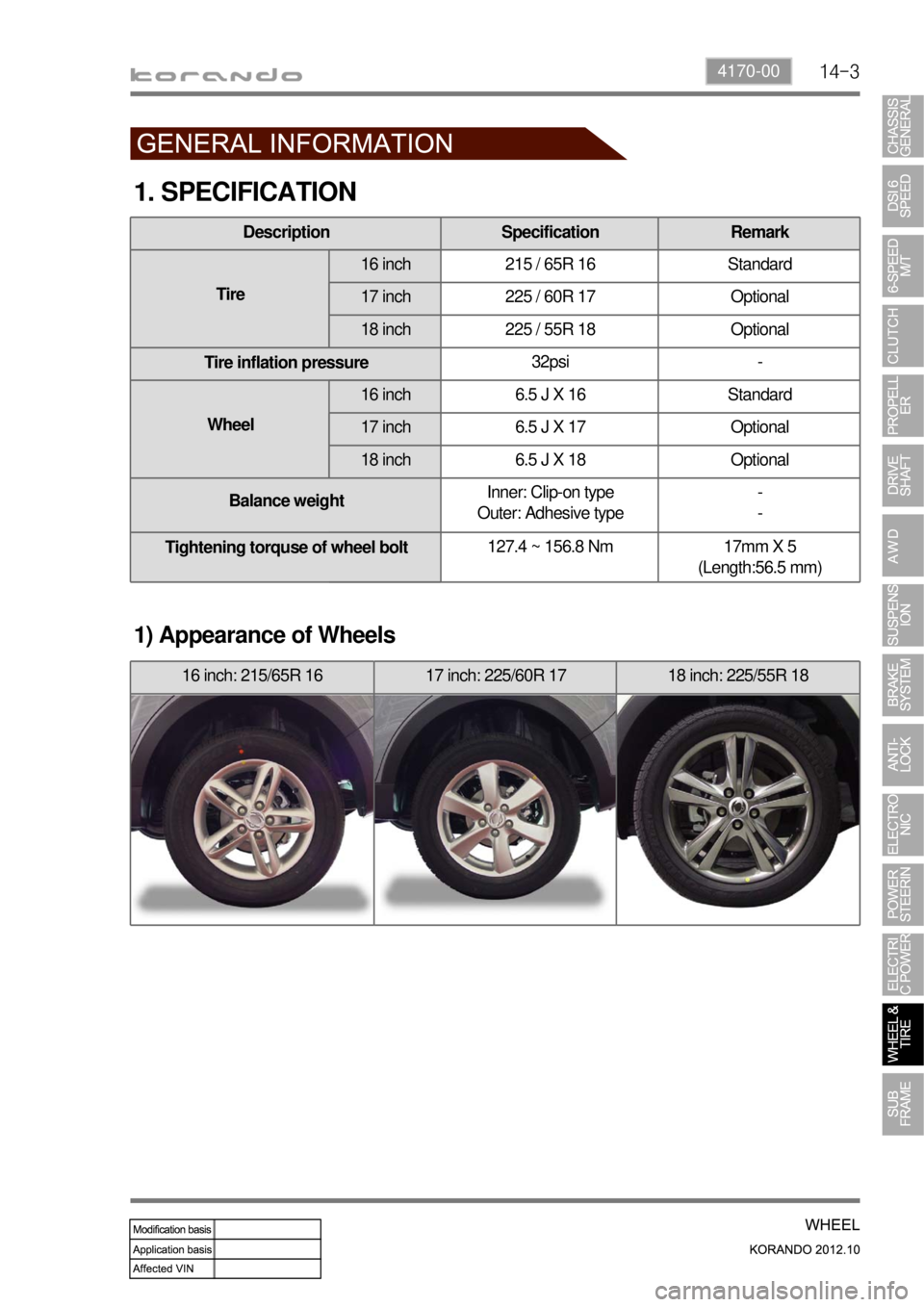
14-34170-00
1. SPECIFICATION
1) Appearance of Wheels
16 inch: 215/65R 16 17 inch: 225/60R 17 18 inch: 225/55R 18
Description Specification Remark
Tire16 inch 215 / 65R 16 Standard
17 inch 225 / 60R 17 Optional
18 inch 225 / 55R 18 Optional
Tire inflation pressure32psi -
Wheel16 inch 6.5 J X 16 Standard
17 inch 6.5 J X 17 Optional
18 inch 6.5 J X 18 Optional
Balance weightInner: Clip-on type
Outer: Adhesive type-
-
Tightening torquse of wheel bolt127.4 ~ 156.8 Nm 17mm X 5
(Length:56.5 mm)
Page 992 of 1082

14-4
1. OVERVIEW
A radial tire uses a cord angle of 90 degrees. That is, the cord material runs in a radial or direct line from
one bead to the other across the tread. In addition, a radial tire has a belt overwrap under the tread
surface to provide greater structural stability. The belt overwrap of a radial tire distortion while the radial
structure enables high speed driving.
Tire supports the weight of the vehicle, reduces the impact from the road and at the same time,
transmits the power to propel, brake and steer on the road. It also functions to maintain a
<009d008c008f0090008a0093008c02c5009a004700940096009d008c0094008c0095009b0055004700700095004700960099008b008c00990047009b00960047008a0096009400970093008c009b008c0047009a009c008a008f0047009b0088009a009200
9a0053004700880047009b00900099008c00470094009c009a>t be structured to be a resilient
vessel of air.
There is wear limit mark on the tire, which protrudes as a strip shape located approximately 1.6 mm from
<009b008f008c0047008e009900960096009d008c004700890096009b009b0096009400550047007b008f0090009a0047009e008c0088009900470093009000940090009b0047009400880099009200470090009a004700950096009b0047009a008c008c00
950047008d0099009600940047009b008f008c00470096009c>tside so there is additional "▲"
mark on the shoulder to let the driver find the wear mark easily. To measure the tire groove depth,
measure at any point other than the point which has a wear limit mark.
The tire is worn unevenly according to the driver's driving habit, improper servicing, low tire inflation
pressure, changed tire location, etc.
1) Structure of Tire
Tread
This thick layer of rubber provides the interface
between the tire and the road. Wear-resistant
rubber is used to protect the carcass and belt
against fractures and impacts and to deliver a
long driving life.
Shoulder
Located between the tread and sidewall, the
shoulder rubber is the thickest so that the design
must allow for the easy diffusion of heat
generated within the tire while driving.
Sidewall
The part between the shoulder and bead, the
flexible sidewall protects the carcass and
enhances the ride. A tire’s type, size,
structure, pattern, manufacturing company,
product name and various characters are
indicated here. Bead
The bead attaches the tire to the rim and wraps
the end of the cord fabric. Comprised of the bead
wire, core, flipper and other parts, the bead is
generally designed to be slightly tight around the
rim so that in the case of a sudden drop in inflation
pressure, the tire will not fall off the rim.
Carcass
As the most important framework of a tire, the
entire inner layer of cord fabric is called the
carcass. The carcass acts to support air pressure,
vertical load and absorb shocks.
Valve
Belt
Bead core
Page 993 of 1082
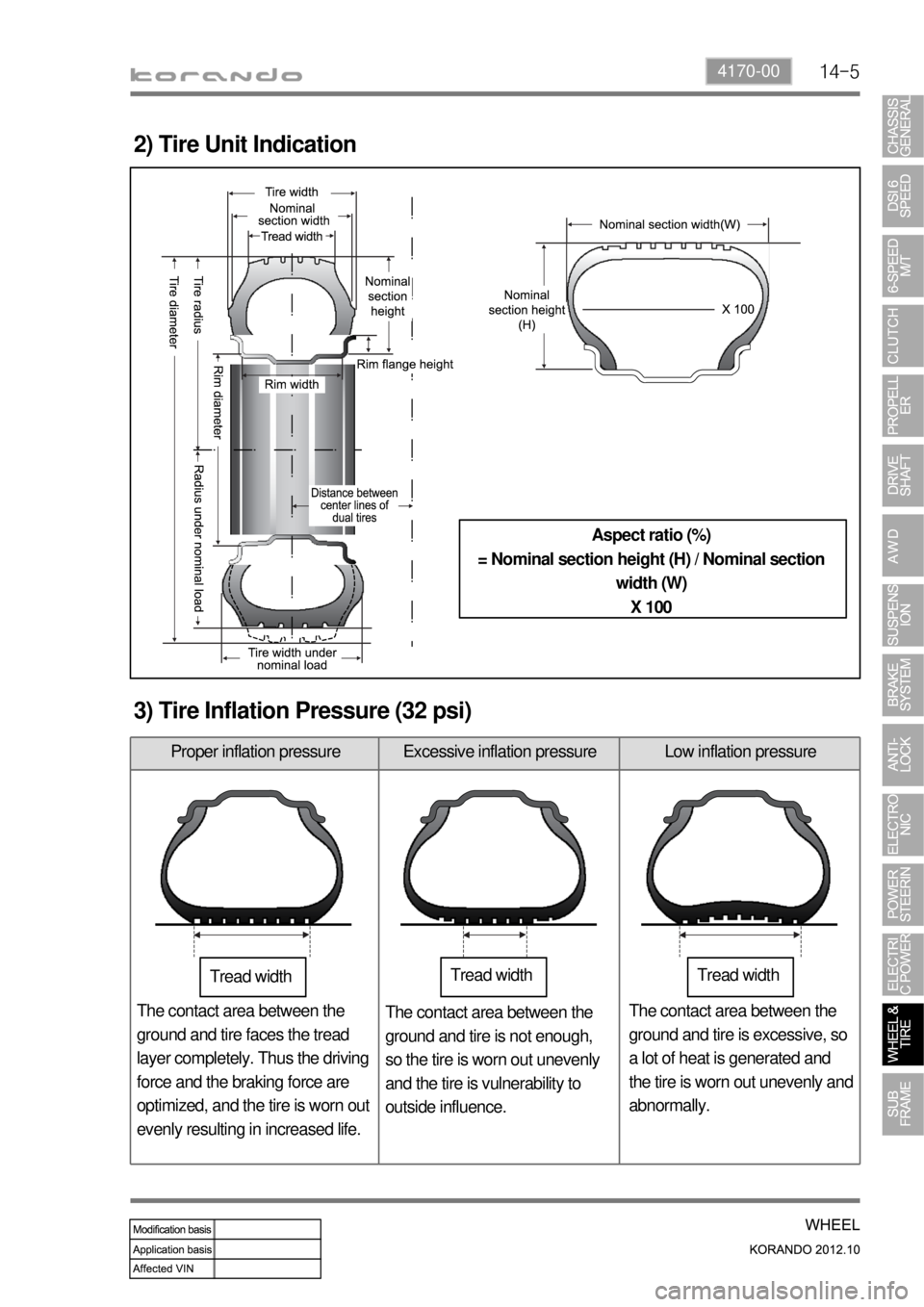
14-54170-00
2) Tire Unit Indication
Aspect ratio (%)
= Nominal section height (H) / Nominal section
width (W)
X 100
3) Tire Inflation Pressure (32 psi)
Proper inflation pressure Excessive inflation pressure Low inflation pressure
The contact area between the
ground and tire faces the tread
layer completely. Thus the driving
force and the braking force are
optimized, and the tire is worn out
evenly resulting in increased life.The contact area between the
ground and tire is not enough,
so the tire is worn out unevenly
and the tire is vulnerability to
outside influence.The contact area between the
ground and tire is excessive, so
a lot of heat is generated and
the tire is worn out unevenly and
abnormally.
Tread widthTread widthTread width
Page 994 of 1082
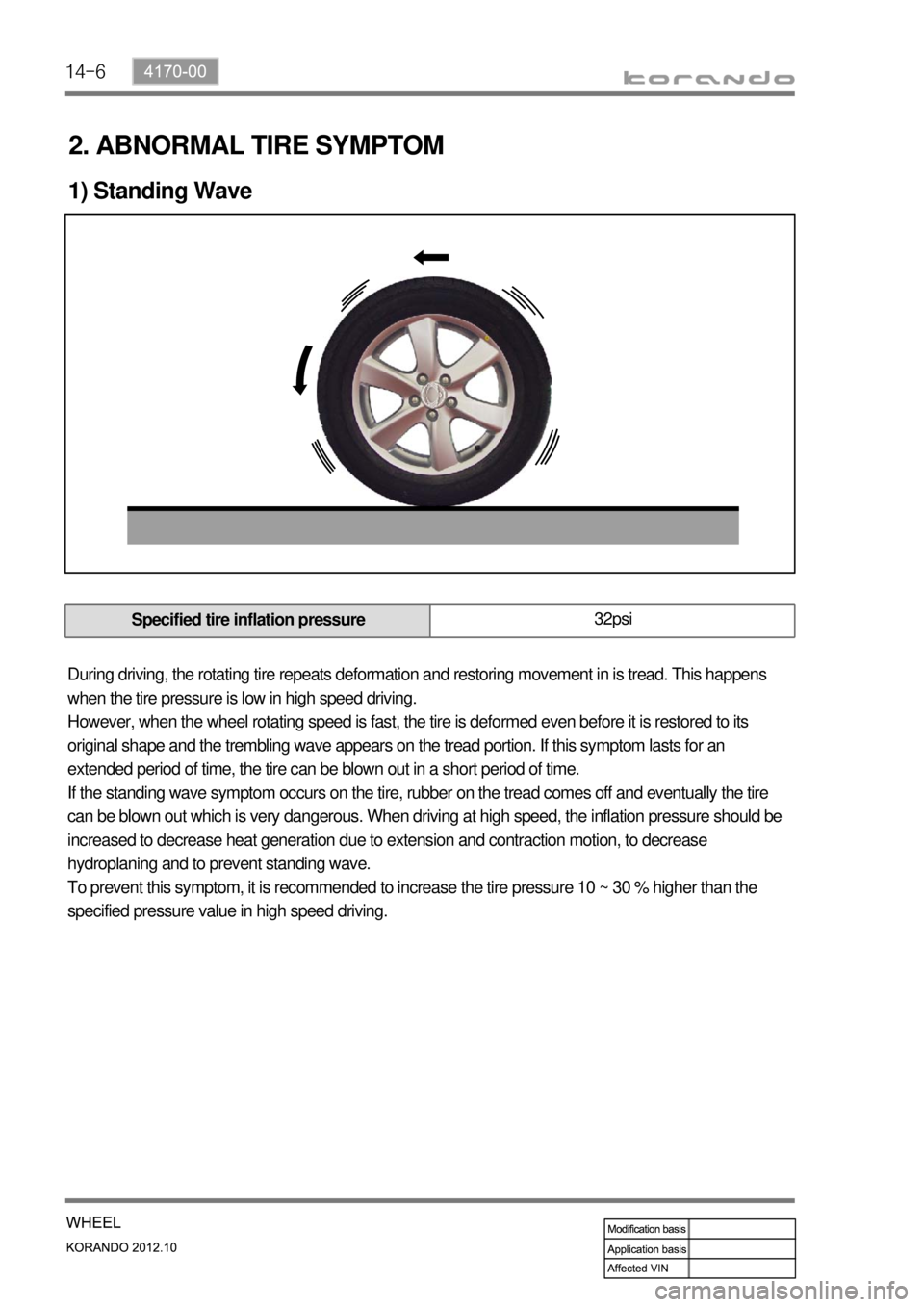
14-6
During driving, the rotating tire repeats deformation and restoring movement in is tread. This happens
when the tire pressure is low in high speed driving.
However, when the wheel rotating speed is fast, the tire is deformed even before it is restored to its
original shape and the trembling wave appears on the tread portion. If this symptom lasts for an
extended period of time, the tire can be blown out in a short period of time.
If the standing wave symptom occurs on the tire, rubber on the tread comes off and eventually the tire
can be blown out which is very dangerous. When driving at high speed, the inflation pressure should be
increased to decrease heat generation due to extension and contraction motion, to decrease
hydroplaning and to prevent standing wave.
To prevent this symptom, it is recommended to increase the tire pressure 10 ~ 30 % higher than the
specified pressure value in high speed driving.
Specified tire inflation pressure32psi
2. ABNORMAL TIRE SYMPTOM
1) Standing Wave
Page 995 of 1082
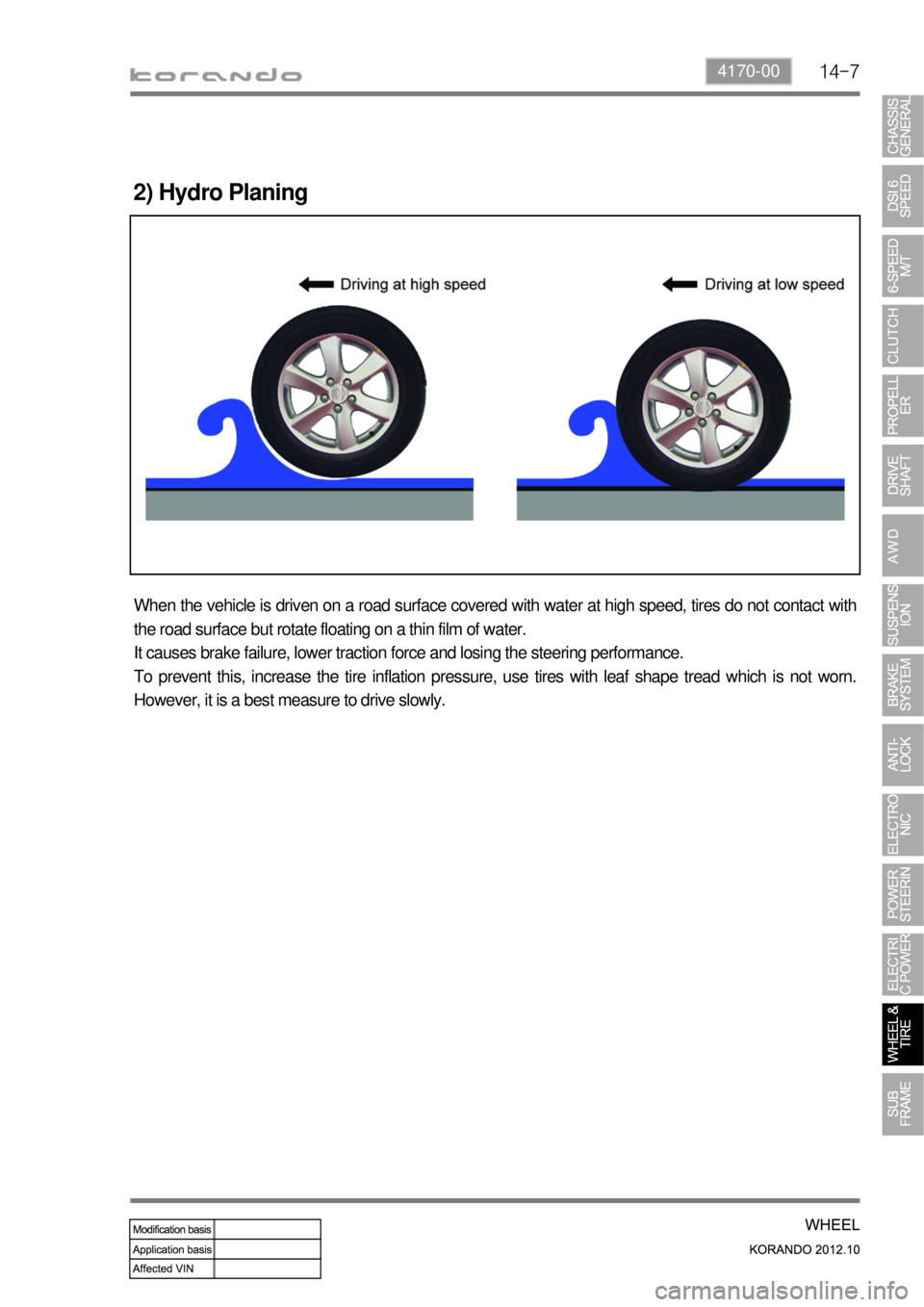
14-74170-00
When the vehicle is driven on a road surface covered with water at high speed, tires do not contact with
the road surface but rotate floating on a thin film of water.
It causes brake failure, lower traction force and losing the steering performance.
To prevent this, increase the tire inflation pressure, use tires with leaf shape tread which is not worn.
However, it is a best measure to drive slowly.
2) Hydro Planing
Page 996 of 1082
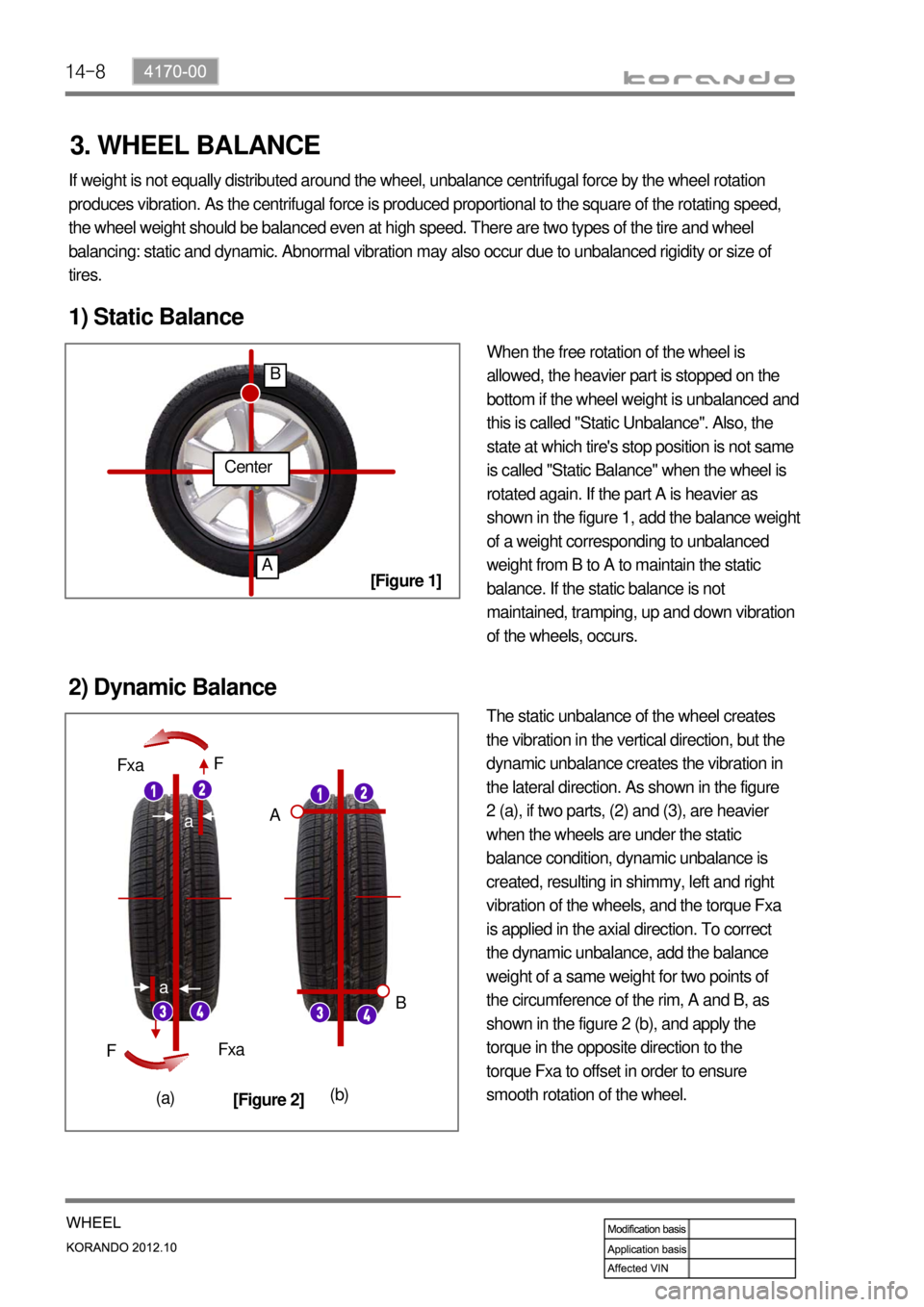
14-8
If weight is not equally distributed around the wheel, unbalance centrifugal force by the wheel rotation
produces vibration. As the centrifugal force is produced proportional to the square of the rotating speed,
the wheel weight should be balanced even at high speed. There are two types of the tire and wheel
balancing: static and dynamic. Abnormal vibration may also occur due to unbalanced rigidity or size of
tires.
1) Static Balance
When the free rotation of the wheel is
allowed, the heavier part is stopped on the
bottom if the wheel weight is unbalanced and
this is called "Static Unbalance". Also, the
state at which tire's stop position is not same
is called "Static Balance" when the wheel is
rotated again. If the part A is heavier as
shown in the figure 1, add the balance weight
of a weight corresponding to unbalanced
weight from B to A to maintain the static
balance. If the static balance is not
maintained, tramping, up and down vibration
of the wheels, occurs.
2) Dynamic Balance
The static unbalance of the wheel creates
the vibration in the vertical direction, but the
dynamic unbalance creates the vibration in
the lateral direction. As shown in the figure
2 (a), if two parts, (2) and (3), are heavier
when the wheels are under the static
balance condition, dynamic unbalance is
created, resulting in shimmy, left and right
vibration of the wheels, and the torque Fxa
is applied in the axial direction. To correct
the dynamic unbalance, add the balance
weight of a same weight for two points of
the circumference of the rim, A and B, as
shown in the figure 2 (b), and apply the
torque in the opposite direction to the
torque Fxa to offset in order to ensure
smooth rotation of the wheel.
Center
A
B
a
a
Fxa
Fxa F
F
A
B
(a)(b)
[Figure 1]
[Figure 2]
3. WHEEL BALANCE
Page 997 of 1082
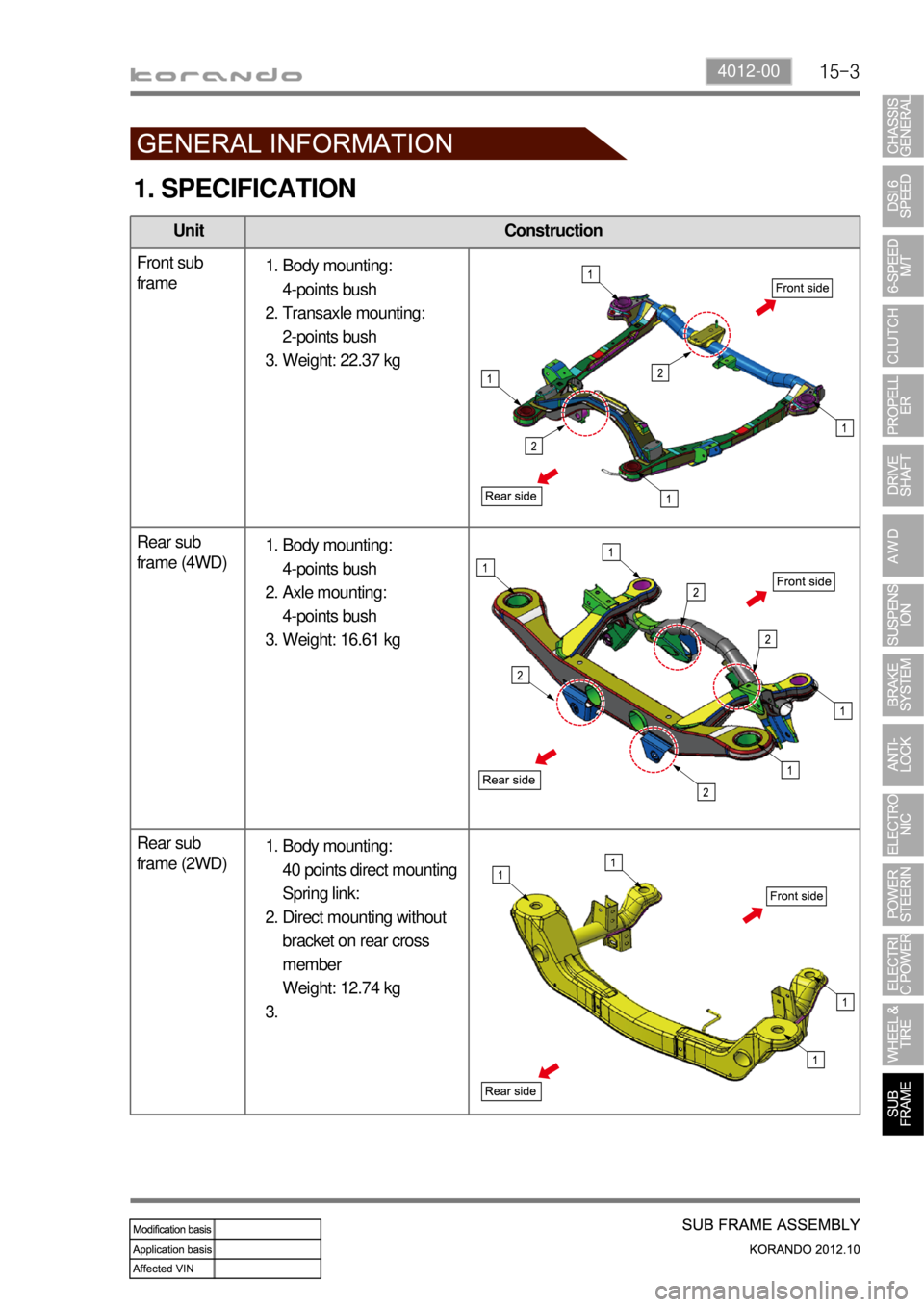
15-34012-00
1. SPECIFICATION
Unit Construction
Front sub
frame
Rear sub
frame (4WD)
Rear sub
frame (2WD)
Body mounting:
4-points bush
Transaxle mounting:
2-points bush
Weight: 22.37 kg 1.
2.
3.
Body mounting:
4-points bush
Axle mounting:
4-points bush
Weight: 16.61 kg 1.
2.
3.
Body mounting:
40 points direct mounting
Spring link:
Direct mounting without
bracket on rear cross
member
Weight: 12.74 kg 1.
2.
3.
Page 998 of 1082

15-4
4. Transaxle mounting (Rear)3. Rear mounting (LH & RH)
2. Front mounting (LH & RH)
1. Transaxle mounting (Front)
2. TIGHTENING TORQUE
Bolt (17 mm) /
Nut (17 mm)68.6 to 88.2 Nm
Bolt (17 mm)88.2 to 107.8 Nm
Bolt (17 mm)88.2 to 107.8 Nm
2 Bracket mounting
bolts (17 mm)88.2 to 107.8 Nm
Bolt (14 mm) /
Nut (14 mm)68.6 to 88.2 Nm
3 Bolts (14 mm)29.4 to 49.0 Nm
Front sub frame - based on 4WD ▶
Page 999 of 1082

15-54012-00
8. Other connections for rear sub frame (LH &
RH)7. Rear axle mounting
5. Front mounting (LH & RH)
Bolt (17 mm)88.2 to 107.8 Nm
6. Rear mounting (LH & RH)
Bolt (17 mm)88.2 to 107.8 Nm
Rear mounting
bolt (14 mm)68.6 to 88.2 Nm
Upper arm bolt
(17 mm) / Nut (19
mm)98.0 to 117.6 Nm
Lower arm nut/Bolt
(19 mm)98.0 to 117.6 Nm
Rear sub frame - based on 4WD ▶
Rear mounting
bolt (17 mm)107.8 to 127.4 Nm
Page 1000 of 1082

15-6
1) Sectional Diagram and Bolts for Front Sub Frame
Mounting nut
29.4 to 39.2 Nm
Bolt9.4 to 39.2 Nm
Installation Sectional diagram
1. Front
2. Rear
Mounting bracket Mounting bolt
3. Transaxle mounting (Front)
For manual transaxle For automatic transaxle
(diesel)
4. Transaxle mounting (Rear)